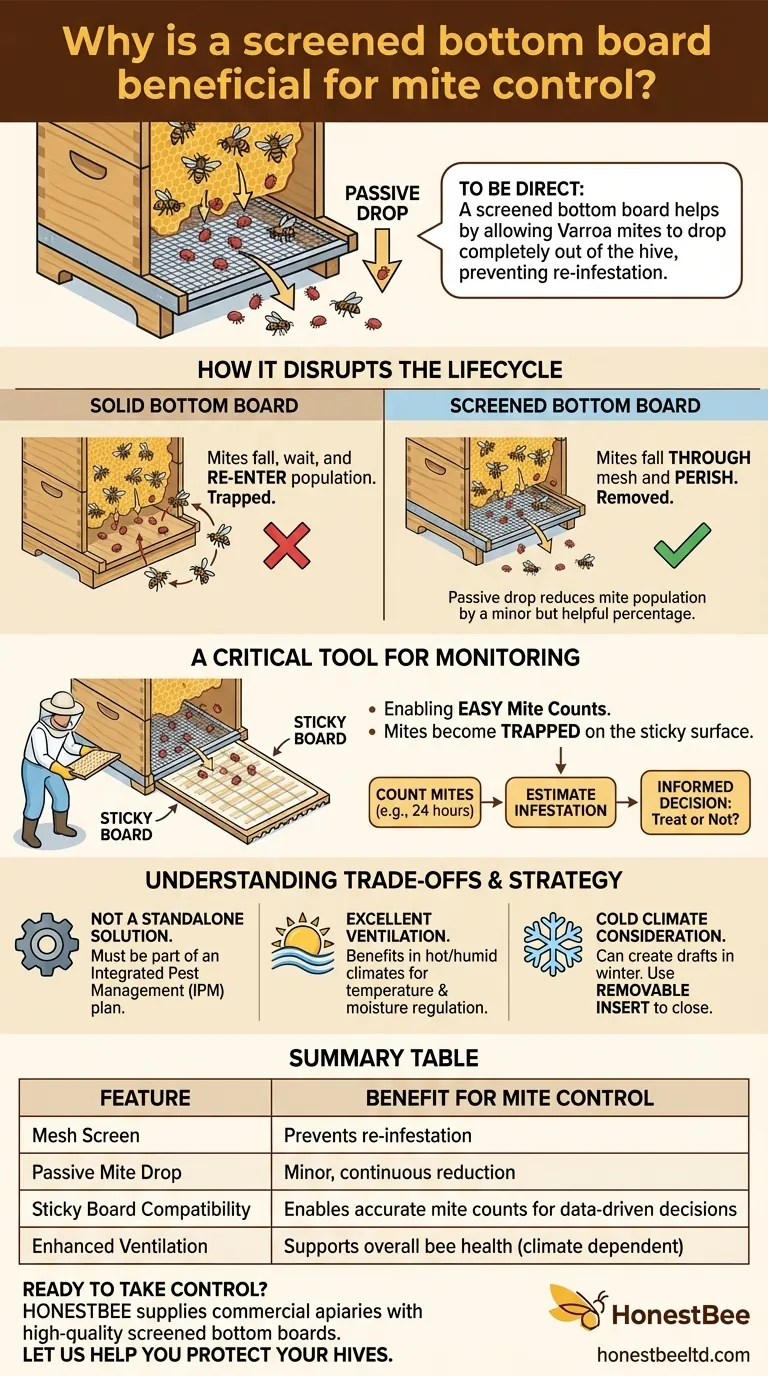To be direct, a screened bottom board helps with mite control primarily by allowing Varroa mites that fall off bees to drop completely out of the hive. This simple mechanism physically removes a portion of the mite population, preventing those mites from climbing back onto other bees and continuing their parasitic lifecycle.
The core benefit is twofold: it provides a minor, passive reduction in mite numbers, but more importantly, it transforms the bottom board into a critical tool for monitoring the hive's overall Varroa infestation level, enabling timely and effective treatment decisions.

How a Screened Bottom Board Disrupts the Mite Lifecycle
The effectiveness of a screened bottom board lies in its simple design, which leverages natural bee behavior to the beekeeper's advantage. It interrupts the Varroa mite's ability to easily find a new host within the hive.
The "Passive Drop" Effect
Bees instinctively groom themselves and each other to remove pests. During this process, Varroa mites can be dislodged and fall to the bottom of the hive.
With a solid bottom board, these mites can simply wait and climb back onto a passing bee, re-entering the population.
With a screened bottom board, many of these fallen mites drop through the mesh and onto the ground below, where they are effectively removed from the colony and perish. While estimates vary, this passive drop can reduce the in-hive mite population by a small but helpful percentage.
A Component, Not a Cure
It is critical to understand that this passive mite reduction is a helpful supplement to an overall mite management strategy.
A screened bottom board alone is not sufficient to control a serious Varroa mite infestation. It reduces the population but does not stop mites from reproducing within the brood cells.
The True Value: A Tool for Monitoring
While the passive mite drop is beneficial, the greatest advantage of a screened bottom board is its role in facilitating accurate mite population counts. This data is essential for responsible beekeeping.
Enabling Easy Mite Counts
Beekeepers can slide a corrugated plastic sheet, often called a "sticky board," under the screen. This board is typically coated with a light layer of oil or petroleum jelly.
As mites fall from the bees—either naturally or during a powdered sugar roll—they pass through the screen and become trapped on the sticky surface below.
From Data to Action
By counting the mites on the board over a set period (e.g., 24 hours), a beekeeper can accurately estimate the infestation level within the colony.
This information is what allows you to make an informed decision about whether and when to treat for Varroa mites, preventing treatments that are either too late or entirely unnecessary.
Understanding the Trade-offs
A screened bottom board is a powerful tool, but it comes with considerations that depend on your climate and management style.
It Is Not a Standalone Solution
Relying solely on a screened bottom board for mite control will likely lead to the eventual collapse of the colony. It must be integrated with a comprehensive Integrated Pest Management (IPM) plan that includes monitoring and, when necessary, approved treatments.
Ventilation vs. Winter Insulation
The excellent ventilation provided by a screen is a major benefit in hot, humid climates, as it helps bees regulate temperature and reduce moisture.
However, in cold climates, this same ventilation can become a liability. An open screen can create a draft, forcing the winter bee cluster to consume more honey and work harder to stay warm. Most screened bottom boards come with a removable insert to close this gap during winter.
Making the Right Choice for Your Apiary
A screened bottom board is a strategic piece of equipment. How you leverage its benefits depends on your primary goals for hive health.
- If your primary focus is passive pest reduction: A screened bottom board provides a simple, low-effort way to slightly reduce mite numbers without chemical intervention.
- If your primary focus is data-driven Varroa management: The board's greatest value is as a tool for conducting "sticky board" mite counts to determine treatment thresholds.
- If your primary focus is hive health in a hot climate: The superior ventilation is a significant advantage for managing in-hive temperature and moisture.
Ultimately, a screened bottom board empowers the beekeeper by providing critical data needed to manage hive health proactively.
Summary Table:
| Feature | Benefit for Mite Control |
|---|---|
| Mesh Screen | Allows fallen Varroa mites to drop out of the hive, preventing re-infestation. |
| Passive Mite Drop | Provides a minor, continuous reduction in the mite population. |
| Sticky Board Compatibility | Enables accurate mite counts for data-driven treatment decisions. |
| Enhanced Ventilation | Helps regulate hive temperature and moisture, supporting overall bee health. |
Ready to take control of Varroa mites in your apiary?
HONESTBEE supplies commercial apiaries and beekeeping equipment distributors with high-quality, durable screened bottom boards and other essential tools. Our wholesale-focused operations ensure you get the reliable equipment you need to implement effective Integrated Pest Management (IPM) strategies.
Let us help you protect your hives. Contact our team today to discuss your needs and get a quote.
Visual Guide

Related Products
- Australian Pine Wood Langstroth Screen Bottom Board for Wholesale
- Langstroth Screen Bottom Board for Beekeeping Wholesale
- HONESTBEE Wooden Bee Escape Board with Triangle Mesh Design for Beekeeping
- Inner Beehive Cover for Beekeeping Bee Hive Inner Cover
- HONESTBEE Professional Frame Wiring Board and Jig
People Also Ask
- Are screened bottom boards necessary for beekeeping? A Strategic Choice for Modern Hive Health
- What are the steps to install wire mesh as a floor in a beehive? A Guide to Better Ventilation & Mite Control
- What additional benefit does a screened bottom board offer? Boost Hive Health & Mite Control
- What features does the screened bottom board with insert offer? Essential Tools for Hive Health and Pest Control
- What are the assembly options for the Cypress Screened Bottom Board? Ready-to-Use for Immediate Hive Health



















